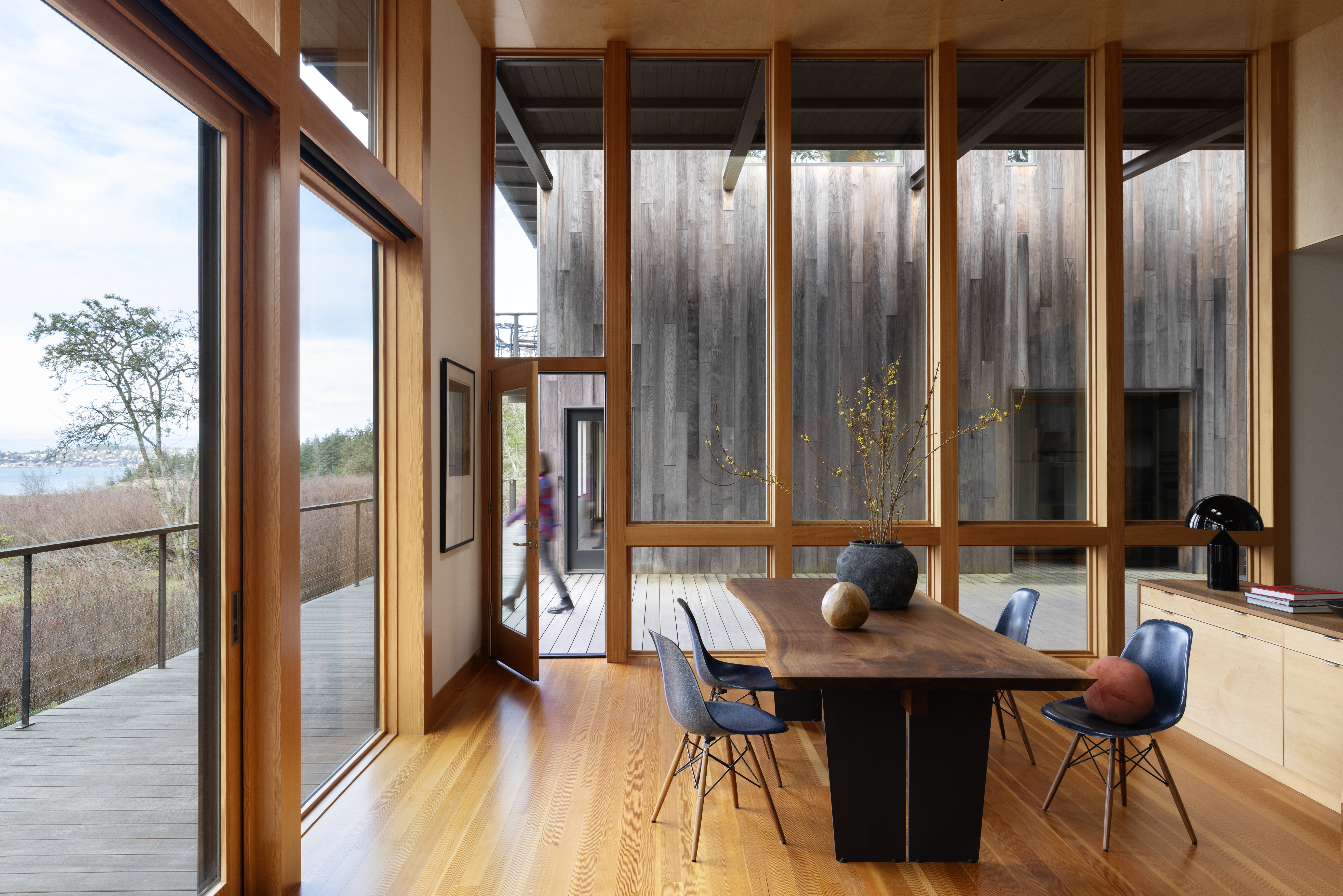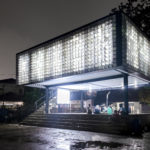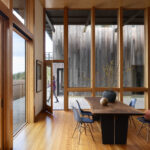Nowhere else in North America does nature feel so powerful, otherworldly and sublime than the Pacific Northwest. With its neverending waterfalls, mountains and evergreen forests, all interwoven with mist, the raw beauty of this unique American landscape is unparalleled.
So how does one build in a place like this? It cannot be easy to create a residence that appears at home in the wildest corner of the frontier. However, architect Dan Shipley, together with builder Peter Bates of Good Home Construction, managed the challenge brilliantly with their Marrowstone Island Residence, a project that complements the epic surroundings of the Pacific Northwest like few others.
Shipley and Bates accomplished this feat through site-responsive design that blurs the line between interior and exterior. Marrowstone Island Residence is not just located in the Pacific Northwest wilderness — it is one with it, thanks in large part to custom windows by Marvin.
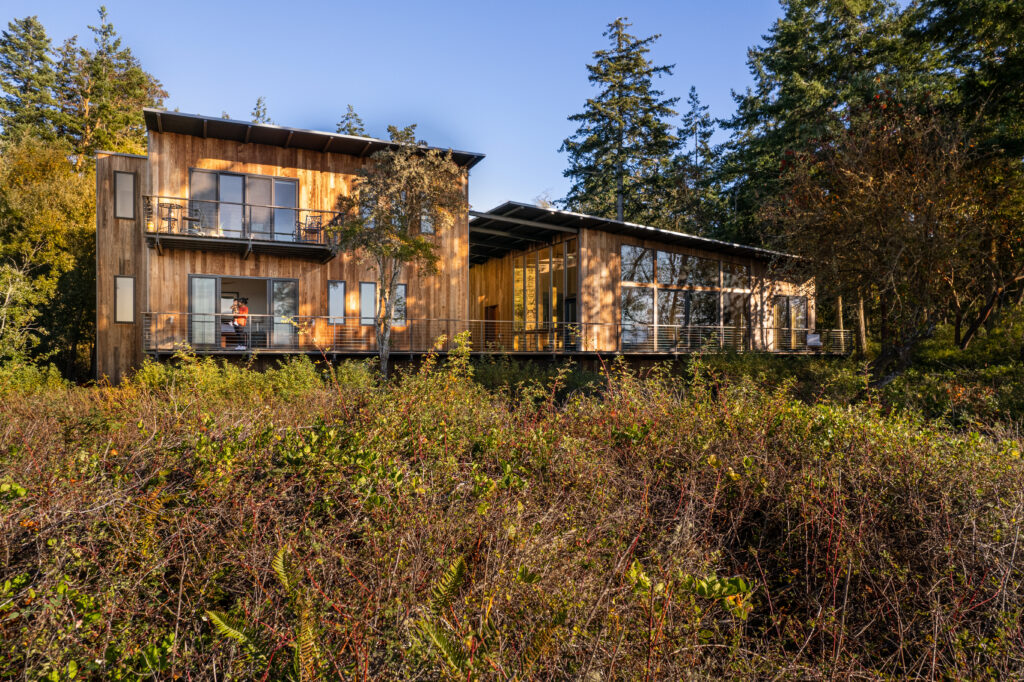 Marrowstone Island is a secluded sliver of land nestled in the waters of Puget Sound north of Seattle, positioned just below Port Townsend and the Strait of Juan de Fuca. The client had passed through this part of the country during his time in the Navy and fell in love with it. After retirement, he purchased 5 acres of wooded wetlands on the northwest end of the island. He met Bates and Aaron MacGregor of Good Home Construction through his realtor, and it was they who suggested the Dallas based Dan Shipley to serve as the architect. The client was also based in Dallas at the time.
Marrowstone Island is a secluded sliver of land nestled in the waters of Puget Sound north of Seattle, positioned just below Port Townsend and the Strait of Juan de Fuca. The client had passed through this part of the country during his time in the Navy and fell in love with it. After retirement, he purchased 5 acres of wooded wetlands on the northwest end of the island. He met Bates and Aaron MacGregor of Good Home Construction through his realtor, and it was they who suggested the Dallas based Dan Shipley to serve as the architect. The client was also based in Dallas at the time.
Port Townsend is known for its tradition of wooden boat making, and both Bates and MacGregor have a background in this venerable craft, a fact that informed how they approached the project. “What translates [from boatmaking] through to building houses, especially building challenging houses, is the attention to detail and the requirement for perfection,” Bates explained. “Needing to be thinking about making things not just good enough, but perfect… Finding creative ways to solve problems is important in both.”
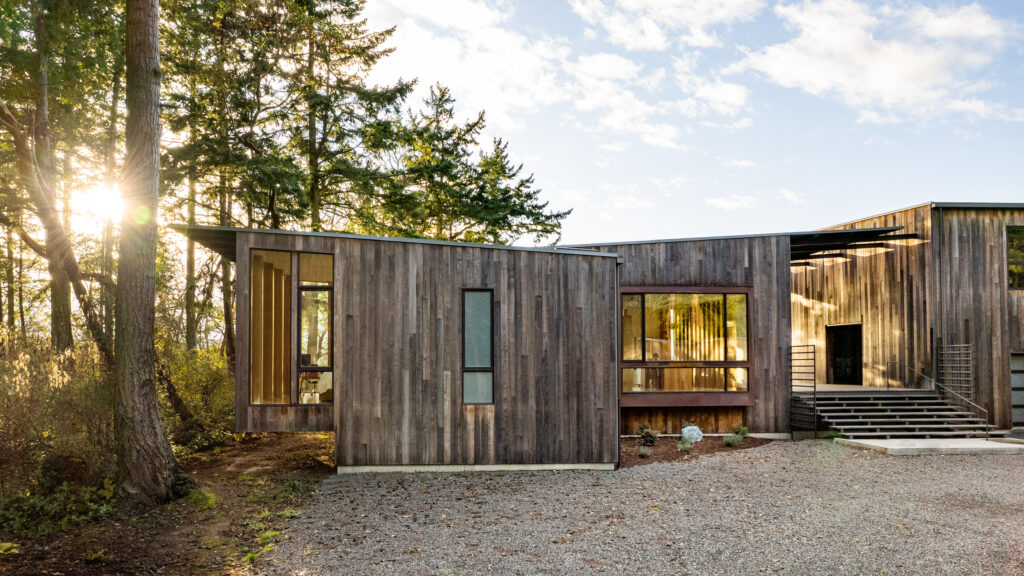 As luck would have it, there were a number of significant problems that arose in the construction of this house, most owing to its setting. “This site has a huge number of challenges on it,” Bates noted bluntly. “As soon as we walked on the site, we could tell there were wetlands. We were squishing, our boots were squishing. We knew we had wetlands, and then you walk to the bluff and you know that you have a 100-foot bluff that’s going down to the shoreline.”
As luck would have it, there were a number of significant problems that arose in the construction of this house, most owing to its setting. “This site has a huge number of challenges on it,” Bates noted bluntly. “As soon as we walked on the site, we could tell there were wetlands. We were squishing, our boots were squishing. We knew we had wetlands, and then you walk to the bluff and you know that you have a 100-foot bluff that’s going down to the shoreline.”
Not to be deterred, Bates and the team chose to consider these barriers as opportunities for site-responsive creativity: “On the one hand, that’s really difficult because there are all these hurdles to overcome. On the other hand, it provides clarity because it sets the parameters that you need to work within.”
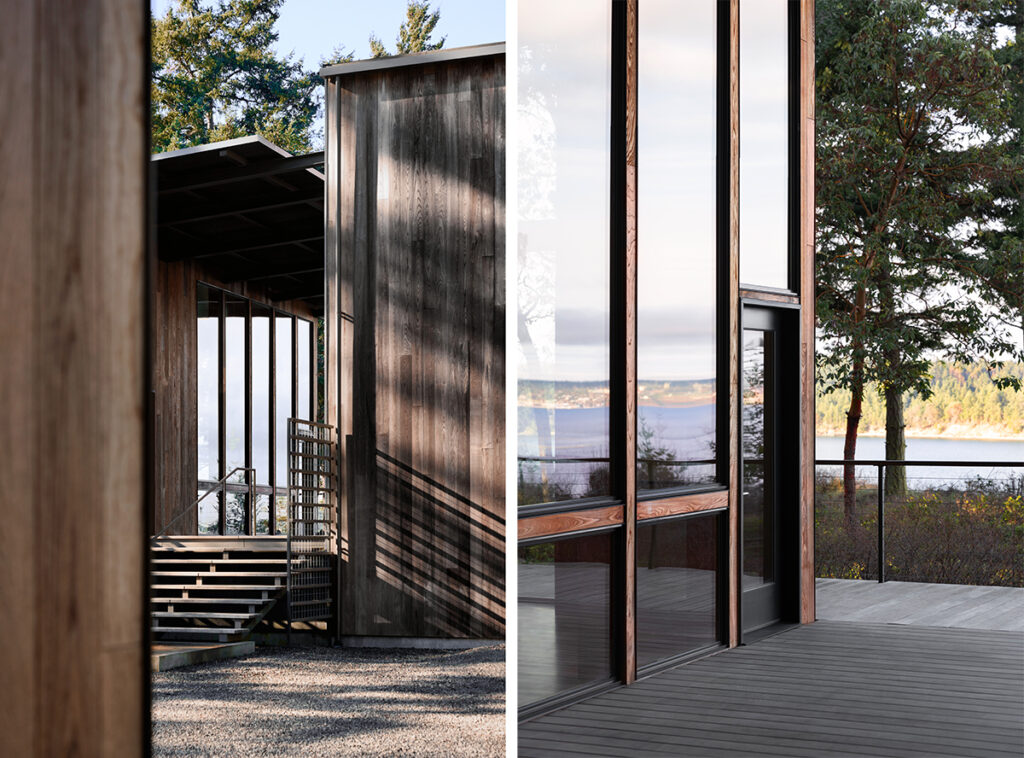 Due to environmental constraints, only a small portion of the densely forested property was suitable for construction. Additionally, to protect the coastline, the builders were required to situate the house 40 feet back from the 100 foot cliff. To assess the potential view, Dan and the construction team propped an extension ladder against a tree and climbed up. From this vantage point, they were greeted not only by a breathtaking view across the bay but also by charming, secondary vistas of the eastern trees.
Due to environmental constraints, only a small portion of the densely forested property was suitable for construction. Additionally, to protect the coastline, the builders were required to situate the house 40 feet back from the 100 foot cliff. To assess the potential view, Dan and the construction team propped an extension ladder against a tree and climbed up. From this vantage point, they were greeted not only by a breathtaking view across the bay but also by charming, secondary vistas of the eastern trees.
 Shipley designed the residence in a dual-section layout along a north-south axis. The northern section encompasses a garage, a guest suite, and an accessory dwelling unit above, while the southern section is dedicated to the main living and sleeping areas. A 14-foot-wide breezeway connects the two parts, offering a spectacular view of the western landscape. The back of the house — that is, the section that faces out over the water — is elevated above a dense thicket of vegetation. Around this home, nature is allowed to be wild and free.
Shipley designed the residence in a dual-section layout along a north-south axis. The northern section encompasses a garage, a guest suite, and an accessory dwelling unit above, while the southern section is dedicated to the main living and sleeping areas. A 14-foot-wide breezeway connects the two parts, offering a spectacular view of the western landscape. The back of the house — that is, the section that faces out over the water — is elevated above a dense thicket of vegetation. Around this home, nature is allowed to be wild and free.
The scheme is simple, but there is beauty in the simplicity — the clean lines that give the details space to breathe. One of the most striking details is the breezeway, which is slightly open on the north side to let in a crack of sunlight, especially in the winter months when the days are short. Another key detail is the cladding, which is made from irregular plans of thermally treated ash, giving the exterior a rugged appearance that echoes the serene evergreen forest. Meanwhile, the interior of the house is warm and luminous, thanks to the hallways clad in maple plywood sheets and floors protected with travertine tile.
 The big stars of the show, however, are the windows. In order to bring their vision to life, the architect and builders worked with Marvin to design custom fittings. Ultimate Specialty Shape windows were selected for the living room and kitchen area, while Ultimate Direct Glaze windows were utilized for the living room, bedroom and study. Two of the bedrooms boast an Ultimate Multi-Slide door, while elegant Casements are featured throughout the residence. The rich, warm hues of Douglas Fir were selected for the interior finish, further connecting the space with the great outdoors.
The big stars of the show, however, are the windows. In order to bring their vision to life, the architect and builders worked with Marvin to design custom fittings. Ultimate Specialty Shape windows were selected for the living room and kitchen area, while Ultimate Direct Glaze windows were utilized for the living room, bedroom and study. Two of the bedrooms boast an Ultimate Multi-Slide door, while elegant Casements are featured throughout the residence. The rich, warm hues of Douglas Fir were selected for the interior finish, further connecting the space with the great outdoors.
“Marvin was a really good choice for us because of how flexible they were to work with,” explained Bates. “When we’re working in this house, we have windows that go essentially floor to ceiling … There’s no trim at the head of the window. On the floor, it’s the same situation. We have flooring that runs right into the bottom of that window that creates the reveal. In order to pull something like that off, you need to have a window manufacturer who understands what you’re trying to do, and who can work with you to make sure that the windows are sized right to fit the holes.”
 In particular, Bates was impressed by the customizability of Marvin Ultimate: “The Marvin Ultimate line was great because they are so customizable, and you can talk to the factory, and you can talk to the reps, and they’ll work with you to say, ‘What are you trying to accomplish? How can we do this? Is that window too big? Will it work this way?’ That was the real appeal of the Ultimate line.”
In particular, Bates was impressed by the customizability of Marvin Ultimate: “The Marvin Ultimate line was great because they are so customizable, and you can talk to the factory, and you can talk to the reps, and they’ll work with you to say, ‘What are you trying to accomplish? How can we do this? Is that window too big? Will it work this way?’ That was the real appeal of the Ultimate line.”
When designing a home in a special place like Marrowstone Island, mass produced pieces do not always cut it. With help from Marvin, and a carefully selected palette of high quality materials, Shipley and Bates were able to bring the wilderness in.
To explore more case studies featuring Marvin Ultimate and learn how to harness windows and doors like these for your next project, click here.
